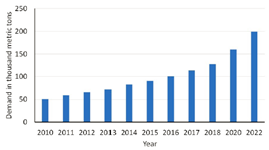Derivation of crack growth law from high cycle fatigue vibration testing in thermoplastic-based composites
Denny Hariadi Simanjuntak - UTwente internal assignment (January 2020)
Thesis: https://essay.utwente.nl/80604/
Summary
The global demand for carbon fiber-reinforced composite is steadily increasing over the years and will continue through foreseeable future as shown in Figure 1. The market for thermoplastics alone is increasing by almost 5%. The interest in thermoplastic composites is growing due to their ability to reshape and reuse. However, in primary aircraft structures, it raises the importance of damage tolerance of this material. The most common failure mechanism in laminated composites is delamination. Therefore, the ability to predict delamination behavior is important, not only for static but also for establishing dynamic damage tolerance criteria.

Figure 1 Global demand for carbon fiber reinforced plastics from 2010 to 2022 (in 1,000 metric tons)
Ply-drop is one of the challenges in tapered composites due to its area of high-stress concentration (Figure 2). Hence, it is likely the point from which the crack and delamination could initiate. The structural discontinuities within the laminate produce out-of-plane stresses, which cause delamination of the composite structure. There are numerous experimental and analytical studies have been reported regarding various aspects of this problem. However, the study on the influence of ply-drop under fatigue behavior, especially with thermoplastic-based composites laminates, still received little attention. Moreover, there is no standard specimen for high cycle fatigue testing. ASTM D6115/ASTM D5228 only specify specimen for a quasi-static load test. A novel ply-drop design has been proposed and tested to better understand the crack growth rate under fatigue tests.

Figure 2 Interlaminar and Intralaminar Damages
This thesis started with designing and manufacturing the fit ply-drops specimen to be studied. The discovered specimens, specimen UD and specimen 0-90 are brought to vibration fatigue test. The specimen themselves are the product of iteration from the manufacturing of composite and vibration testing. The effect of high cycle fatigue is evaluated through its stiffness degradation, involving dynamics parameters, and micrograph to understand its structural performance.
The results give an understanding of structural integrity change of thermoplastic composite, which is reflected by stiffness degradation, response phase shift, and base acceleration, and resonance frequency decay caused by the crack propagation. Furthermore, the characterization of fatigue of both specimens is determined. 3D Finite Element (FE) model is carried out with the use of ANSYS-Software to simulate the real experiment to understand the involving stress, which is used to determine the strain energy release rate. The strain energy release rate that influences the delamination growth is found. Delamination growth per fatigue cycle, da/dN, which is from the experiment is related to strain energy release rate, G from the model as shown in Figure 3. At last, the ultimate aim of derivation crack growth law, which is an expression that relates delamination growth per cycle with strain energy release rate, G, is determined. The exponents of the power-law relationship can be used as a crack growth prediction tool in the case of vibration fatigue loading

Figure 3 Propagation Rate Specimen 0-90 from Pristine model and Case of Crack Model
KEY RESULTS
1. Thermoplastic-based composite, in this case, TC 1320 PEKK, is found highly resistant to fatigue. For ply-drops testing specimen, it needs pre-existence crack as crack initiator.
2. The effect of crack on dynamic parameters has been explained and employed to monitor crack initiation. Base acceleration trace and phase response shift can clearly explain when the crack is initiating and start propagating. The phase response shift is found more sensitive than the base acceleration trace. The three events from initiation until propagation have already been established.
3. Paris law has been derived from ply-drop based thermoplastic. The good agreement on the value of variable m found between different stacking sequences, specimen UD, and 0-90, which means it reflects the characteristic of identical material properties of both composites. The difference is the result of different stacking sequences, which gives different propagation rates.
